Mitchell Taylor Workshop pairs timber with aluminium at Berkshire music college
A recital hall covered in aluminium mesh projects from one corner of this timber-clad music and communications centre designed by Mitchell Taylor Workshop for a college in the south of England.
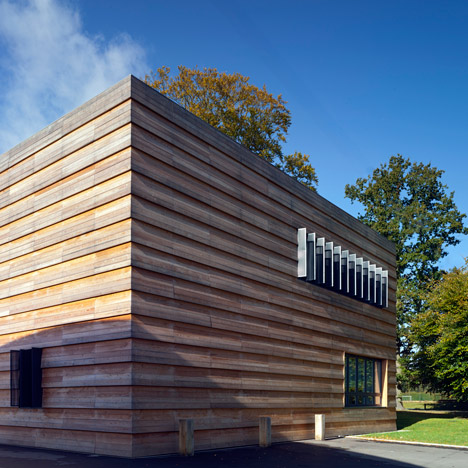
Pangbourne College in Reading asked British studio Mitchell Taylor Workshop to create a modern structure to accommodate its music and information/communications technology departments, which were previously housed in ageing temporary classrooms.
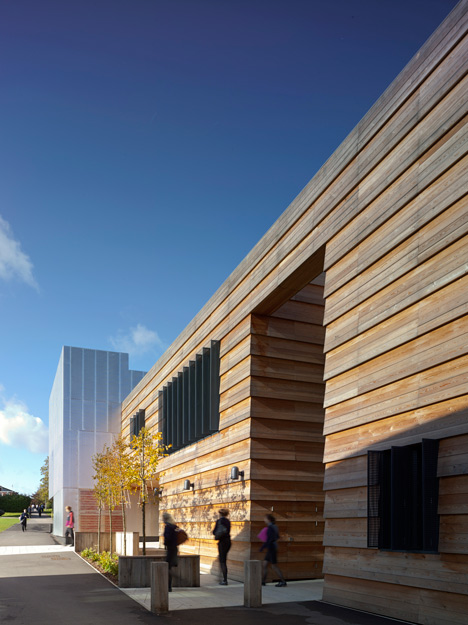
Located at a prominent position close to the college's entrance, the building faces the central quadrangle and is flanked on the opposite side by a row of mature trees.
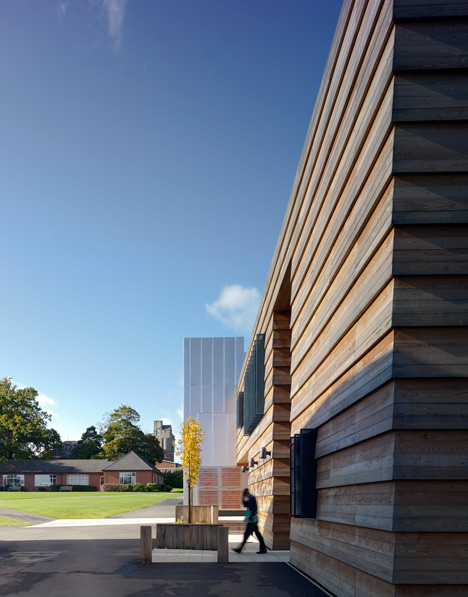
The textured expanded aluminium surface of the recital hall gives it a distinctive presence and was chosen to contrast with the wooden facade surrounding the rest of the building.
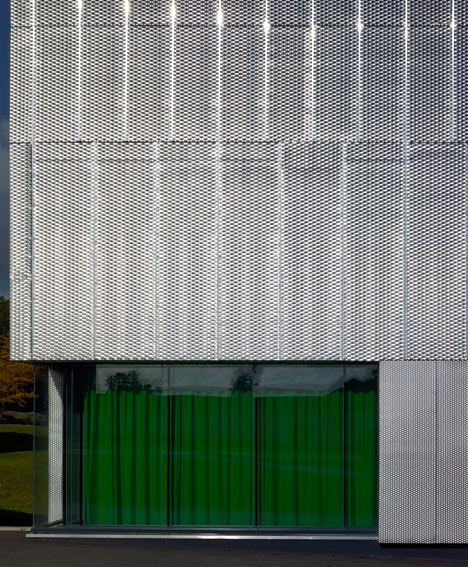
"We didn't just want one big timber box and we felt it would be nice to add some texture," architect Rob Mitchell told Dezeen. "The aluminium pushes the industrial character of what is an entirely functional part of the building."
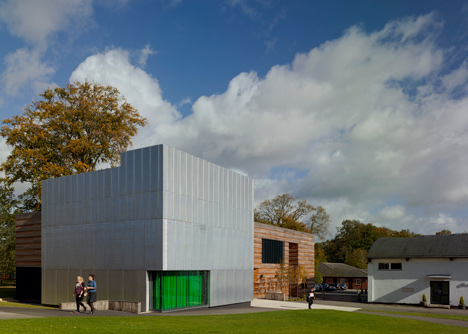
Research visits with the client to other music schools identified the need for a "lively, characterful music space", which the architects interpreted as an adaptable interior that allows rooms to be acoustically isolated or opened up as desired.
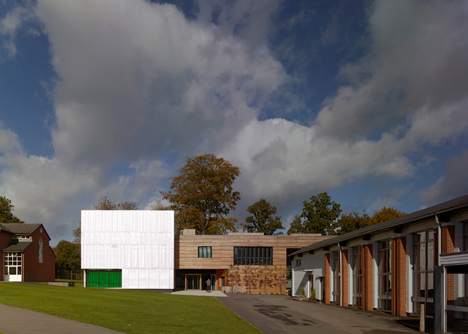
"The project delivers a bespoke and technical response to the sometimes conflicting issues of a quiet classroom space and adjacent loud music practice and performance spaces," the team explained.
"The design incorporates flexibility within spaces to allow different spaces to be opened up or isolated, but began with a careful distribution of compatible spaces through the plan."
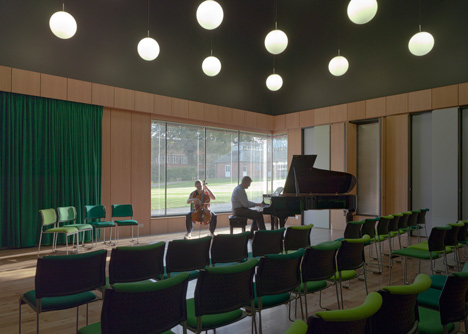
Responding to the desire for natural ventilation while reducing the spread of noise between the different spaces, acoustic baffles in the form of vertical metal louvres were installed between windows to deflect sound.
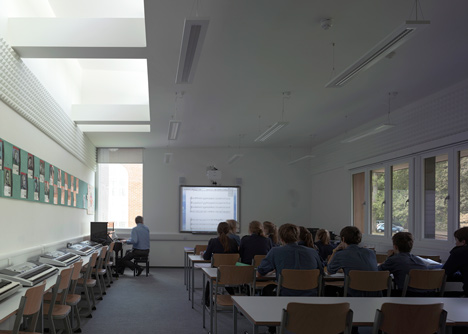
On the south and west facades, windows that interrupt the larch cladding are fitted with perforated metal shades that protect the interiors from direct sunlight.
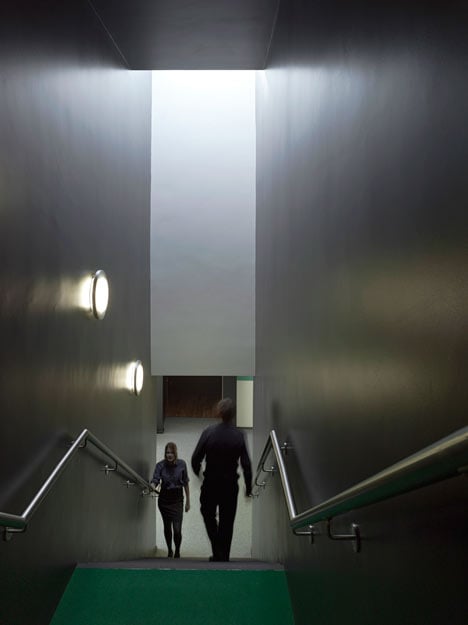
A large opening at the end of a paved forecourt marks the entrance that leads to a foyer at the centre of the facility.
As well as the double-height recital room, the ground floor contains variously sized practice rooms, instrument storage, offices and a drop-in room for the computing department.
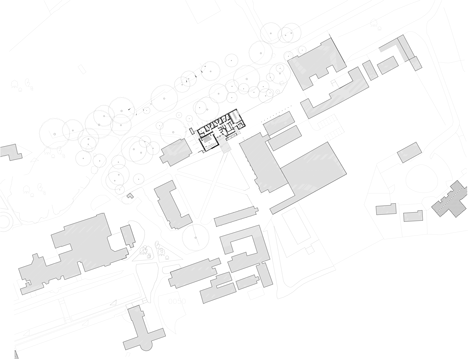
The recording-quality acoustics of the recital room are aided by the integration of wall panels that can be opened to reveal a soft sound-absorbing surface.
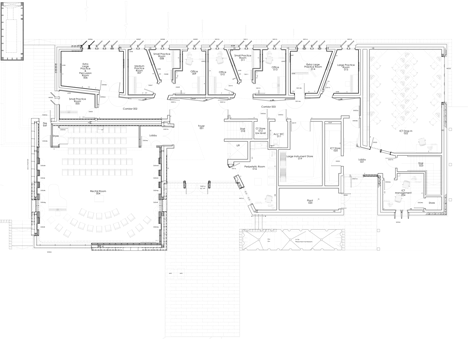
A staircase ascends from the foyer to the first floor, which houses a control room, studio booth and recording room, as well as classrooms for the information and communications technology pupils.
At the rear of the building, a section has been removed to create space for an outdoor terrace that looks out towards the neighbouring trees.
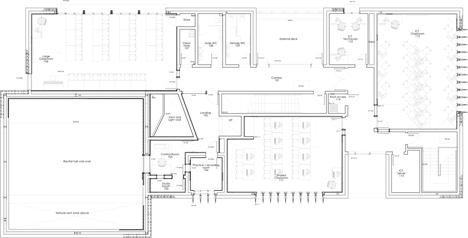
Mitchell Taylor Workshop has also designed a school building in the Bath which contrasts dark brick with stone walls that reference the city's traditional architecture.
Here's a project description from Mitchell Taylor Workshop:
The Harding Communications Centre, Pangbourne, Reading, UK
The Communications Centre at Pangbourne College brings together the faculties of Music and ICT into one new building. The client was looking for a high quality, forward thinking modern building at the very front of their campus.
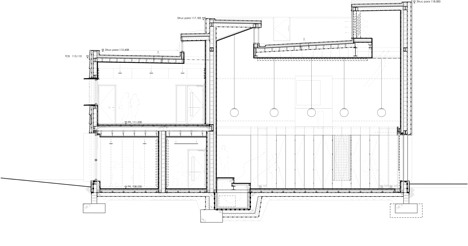
The client brief was to provide a high quality, forward thinking, modern building that would make a statement at the entrance to the College and would set out the intentions of the College as they move to the future. The building was required to relocate the two existing faculties from tired and long-lived temporary classrooms. The Headmaster led the client team and guided the client brief from the governors. The brief was to provide ICT classrooms and drop-in, music classrooms, music practice spaces, a recital space and top quality recording facilities. The building was to be funded entirely by donations and therefore the challenge of providing a very cost effective building was always a key driver. The client wanted careful control of a tight budget but always aspired towards delivering something special.
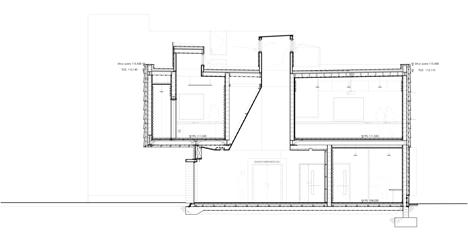
Through the initial design phases we encouraged visits to other music schools with the client which prompted a discussion and evaluation of what the College actually wanted from their new building in detail. Importantly this process gave the brief the desire to have a lively characterful music space, (rather than always acoustically isolated.)
The College site is within the west Berkshire AONB and the campus includes listed buildings. A good relationship was developed with the local authority through the process and this helped us gain a delegated consent for what is a challenging building in this situation. The site is a sloping site at the edge of the central College quadrangle and is bordered by mature trees. These were both a constraint and one of the joys of the final scheme.
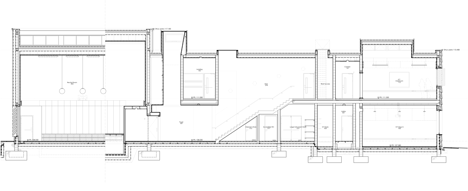
The project delivers a bespoke and technical response to the sometimes conflicting issues of a quiet classroom space and adjacent loud music practice and performance spaces. The design incorporates flexibility within spaces to allow different spaces to be opened up or isolated, but began with a careful distribution of compatible spaces through the plan. The build was to a very high standard in terms of acoustics and also energy design. The scheme met the stringent BREEAM Excellent standards through a passive design, super insulation, high thermal mass and careful control of natural light and ventilation. Natural ventilation and acoustic control are not always convenient partners but we strove to provide a natural solution.
The design uses bespoke acoustic baffles that we developed to limit cross-talk between open windows. The main recital space even ventilates naturally despite its recording studio quality environment. This is thanks to a design for an incoming below ground plenum that attenuates external noise and also helps gently cool incoming air when required. Air then rises to a high level acoustic damper louvre. Double layered door openings allow manual enhanced ventilation in a simple way. The recital space also includes a series of designed joinery wall panels that can be easily opened to expose soft attenuating panels that can tune the space acoustically. The spaces also carefully use daylight to provide an excellent light quality largely thanks to top light and North light working together. Solar shades allow control of the light from the South to limit glare.

Externally the building is conceived as the intersection of two volumes, one of timber and one of aluminium. The mill finish aluminium expanded metal cladding wraps up the recital hall 'cube' and is seamless with the exception of the punctured open corner glazing. The timber cladding was designed to be constructed in panels to remove the impression of narrow board timber cladding and to give some relief to the facade. The natural larch cladding is interrupted by the vertical folded metal solar shades. To the rear amongst the large trees the cladding is opened up to reveal acoustic baffles to the music practice rooms behind, giving a lively active facade to the main approach to the College.
The construction is largely in heavy-weight masonry with very deep external insulation that wraps up this thermal (and acoustic) mass. This makes for a building that retains heat and cools and makes for a comfortable place to be.

Sustainability
From the briefing stage we pressed the sustainable agenda for the building and challenged ourselves and the design team to create a naturally ventilated building that also responded to the acoustic needs of a classroom environment, a recital hall, recording studios and music practice.
The structure of the building is inverted which allows the thermally massive masonry walls and concrete upper floor to be exposed thermal mass. This single deep masonry wall is the wrapped up in 200mm of very high performance insulation, (a-rated in the green guide). The insulation is continuous from below ground, over the parapet eaves and across the roof. Over heating is potentially a big challenge to the design of these environments due to their intensive internal use. The cladding is stood off from the insulated facade to allow a ventilated space to avoid over-heating. The flat roof is even white in colour to help reflect the summer sun. This sets the fundamental tone for the building as it needs very little heat input and retains heat very well. The fabric will store warmth but can also be used in the summer condition for night cooling due to its ventilation strategy.

The building is naturally ventilated. In classrooms this is via large amounts of opening windows, using cross-ventilation where possible and then being enhanced by north-facing roof lights that can be used for safe night cooling. The added benefit of using openable glazing for ventilation is the excellent quality of daylight that this provides.
The practice rooms are ventilated by opening windows that open at high and low level to allow better circulation of air in these smaller spaces. The challenge here was for these opening windows in potentially loud spaces to not undo the work of the acoustically separate walls and floors from space to space. We came up with the idea of external acoustic baffles that attenuate the sound from one direction and reflect it away from the other. This acoustic baffle is also used vertically from practice room to classroom over.

The recital hall is also naturally ventilated despite having a potential occupancy of over 70 and the requirement to be acoustically isolated. The design uses a low level plenum duct to draw fresh cooler air below ground behind the staging. The air is allowed to circulate naturally to a high level louvre system which includes attenuated louvres. Again, night cooling can also be taken advantage of. At peak use times there are simple manual ventilation doors that can be opened from the flush internal linings to reveal large vents behind and allow simple, instinctive, operable ventilation.
Solar over-heating is avoided due to the largely north aspect, but where the southern elevation is used it benefits from external solar shades made from folded perforated sheet. The systems design then back-up this sustainable strategy with artificial lights on automatic daylight and occupancy controls and low energy fittings throughout.

The building takes very little energy to heat, but is carefully managed by a BMS system and is supplied by a district heating system from the College central plant. The designs for this plant to be upgraded to run as a biomass energy centre using fuel from the college 400acre estate. Ultimately the desire is to remove the reliance on oil fuel and move forward towards energy self-sufficiency.
The building is sustainable from its very heart; it is forward looking, out performs building regulations by a significant margin into the future, and is very low energy. The construction was managed for low waste through design, detailing and careful site control. Materials such as the cladding are used in their natural state and will require very little maintenance. Ultimately the building is very recyclable and re-useable.
Client: Pangbourne College
Cost: £1.5m
Contract: Traditional JCT 05
Value: £1,875/sq.m
Duration: 45 weeks